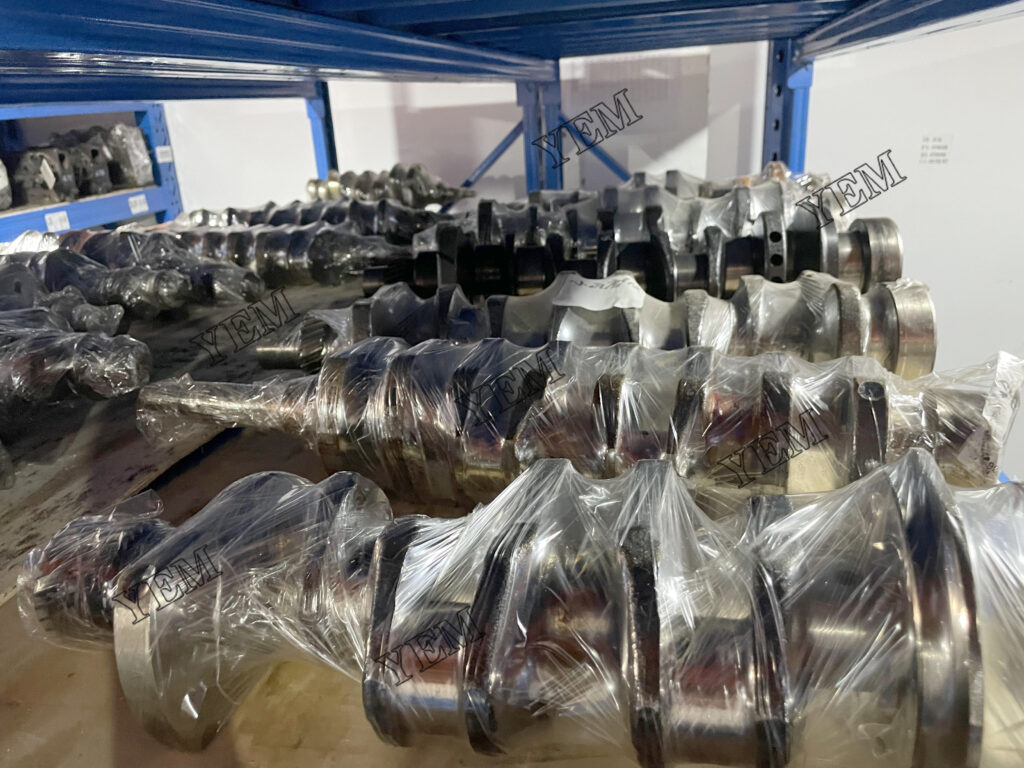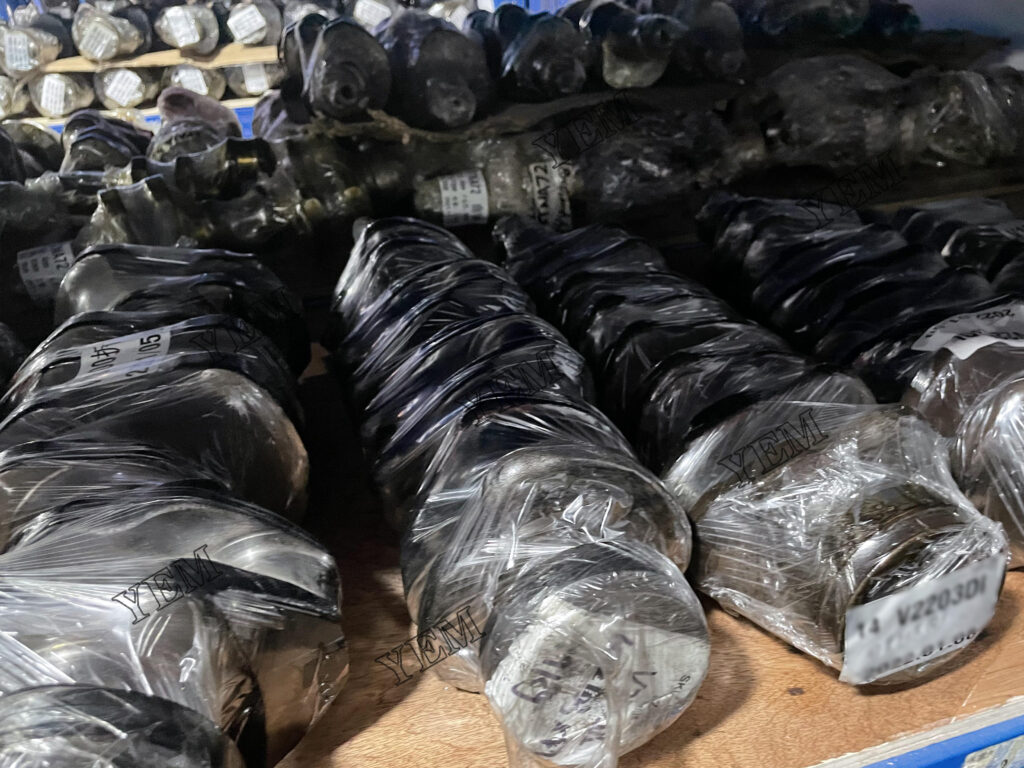The engine crankshaft is one of the key components of the internal combustion engine. It converts the up and down reciprocating motion of the piston into rotary motion to drive vehicles or mechanical equipment. Here’s how an engine crankshaft works:
- Crankshaft structure: The crankshaft is usually made of a long, strong metal rod with multiple eccentric necks and connecting rod pin holes. The central axis of the crankshaft is called the main shaft, along which there are several eccentric journals, each connected to a piston.
- Piston movement: During the working process of the internal combustion engine, the piston reciprocates up and down in the cylinder. When the piston moves downward, the mixture in the combustion chamber is compressed; when the piston moves upward, the mixture is ignited and burned, generating explosive force to move the piston downward.
- Connecting rod connection: Connect the crankshaft through the connecting rod. One end of the connection is connected to the piston, and the other end is connected to the curved connecting rod pin hole. This connection allows the up and down reciprocation of the piston to be transmitted to the crankshaft.
- Converting motion: When the piston moves down, the connecting rod converts the linear motion of the piston into the rotary motion of the crankshaft. The connecting rod pin holes on the crankshaft rotate around the arbor journal so that the crankshaft rotates with it.
- Output power: The rotational motion of the crankshaft is transmitted to other parts of the vehicle or mechanical equipment through a transmission device (such as a gear belt, etc.), thereby generating power to drive the vehicle or perform other tasks.

To sum up, the working principle of the engine crankshaft is to convert the up and down reciprocating motion of the piston into the rotational motion of the crankshaft, and realize this transformation process through the connecting rod connection, and finally output power.
The crankshaft is one of the key components of the engine, it has a specific structure and function as follows:
- Structure:
- Main axis The central axis of the crankshaft, along which the rotational movement takes place.
- Eccentric journal: The raised part on the crankshaft, connected with the connecting rod, converts the up and down reciprocating motion of the piston into a rotary motion.
- Connecting rod pin hole: Located on the eccentric journal, it is used to connect the connecting rod, and the piston movement is transmitted to the crankshaft.
- Function:
- Converting motion: The main function of the shaft is to convert the up and down reciprocating motion of the piston into the rotary motion of the crankshaft. As the piston moves downward, the connecting rod converts the linear motion of the piston into rotational motion of the crankshaft.
- Balance vibration: the shaft also has the function of balancing vibration. Since the working process of the engine will produce unbalanced forces, the crankshaft can balance these unbalanced forces by designing reasonable spindle journal positions and volume distribution, reducing vibration and noise.
- Drive accessories: There are usually accessory drives on the crankshaft, such as generators, water, air-conditioning compressors. The rotational motion of the crankshaft can be powered by these accessory drives for normal operation.
In combination, the structure of the crankshaft includes a main axis, an eccentric journal and a pin hole. Its function is to convert the up and down reciprocating motion of the piston into the rotational motion of the crankshaft, balance the vibration, and drive the accessory device at the same time. These functions allow the engine to operate normally and output power.

The engine crankshaft is an important part of the internal combustion engine, which converts the reciprocating motion of the pistons into rotary motion to drive vehicles or mechanical equipment. Designing and optimizing an engine crankshaft requires consideration of several factors, including performance, availability, and manufacturing cost.
The following are some common engine crankshaft design and optimization principles:
- Strength and stiffness: The crankshaft must have sufficient strength and stiffness to withstand working loads under high pressure and high speed. Material selection and geometry are critical to achieving the desired strength and stiffness.
- Reduced mass and inertia: Reducing crankshaft mass and inertia improves engine responsiveness and fuel economy. This can be achieved with lightweight materials, optimized geometry and the use of balance shaft technology.
- Optimum balance: The balance of the crankshaft is not important to reduce vibration and noise. Unbalanced moments and vibration levels can be reduced through reasonable geometric design and adding balance weights.
- Lubrication system: The lubrication system on the crankshaft must be able to effectively lubricate the crankshaft bearings and reduce frictional losses. Optimizing the oil passage design and using appropriate lubricating materials can improve the lubrication effect.
- Manufacturing cost: Manufacturing cost is also an important consideration in crankshaft design. The manufacturing cost can be reduced through rational shape design, material selection and manufacturing process optimization.
- Stability of power output: The design of the crankshaft should minimize power pulsation and torque fluctuation to provide smooth power output. It can be achieved by optimizing the cylinder arrangement, reducing the connecting rod angle and adopting balance shafts.
- Durability and reliability: The crankshaft must have sufficient durability and reliability to be able to withstand the requirements of long-term high-load operation. Aspects such as material strength, surface treatment and fatigue classification need to be fully considered.
The above are just some common engine crankshaft design optimization principles, and the actual design process needs to be comprehensively considered according to the specific engine type, application scenario and performance.
The engine crankshaft is one of the important parts of the engine. It is responsible for converting the piston motion into rotary motion to drive the car or mechanical equipment. The following is some basic information about engine crankshaft machining and inspection:
- Crankshaft processing:
- Manufacturing process: The crankshaft is usually made of high-strength alloy steel material and processed in multiple steps. These processes include forging, turning, grinding, quenching, etc.
- Forging: Through heat treatment and forging process, the steel billet is heated to an appropriate temperature, and pressure is applied in the mold to form the preliminary shape of the crankshaft.
- Turning: The forged crankshaft is precisely turned using mechanical equipment such as a lathe to obtain the desired size and shape.
- Grinding: Finely grind the turned crankshaft with a grinding machine to improve surface finish and dimensional accuracy.
- Quenching: Heating the processed crankshaft to an appropriate temperature and cooling it quickly to increase hardness and strength.
- Crankshaft detection:
- Dimensional measurement: Use measuring tools (such as micrometers, vernier calipers, coordinate measuring machines, etc.) to measure the key dimensions of the crankshaft to ensure that it meets the design requirements.
- Surface quality inspection: Check the surface of the crankshaft for cracks, fatigue, etc. by visual inspection using non-destructive testing methods such as flaw detection.
- Dynamic balance test: install the crankshaft on a balancing machine, and check the balance performance of the crankshaft through a rotation test to ensure that no vibration and noise will be generated during high-speed rotation.
- Material composition analysis: through sampling and chemical analysis, determine whether the composition of the shaft material meets the standard requirements.
The above is the general process and method of engine crankshaft machining and testing. It should be noted that specific processing and testing procedures may vary by manufacturer’s engine type and specification.

The crankshaft is one of the important parts of the engine, which is responsible for turning the piston motion into rotary motion and transmitting it to other parts through the connecting rod. If the crankshaft fails, the engine may not work properly or be severely damaged. The following are the general steps for crankshaft failure analysis and repair:
- Failure analysis:
- Check the engine for unusual noise or vibration.
- Watch for engine loss of power or erratic operation.
- Check that the engine oil pressure is normal.
- Check crankshaft sensor for false signal.
- Check the crankshaft for wear:
- Disassemble the engine and take out the crankshaft.
- Carefully inspect the surface of the crankshaft for scratches, cracks or wear.
- Check that the diameter and roundness of the crankshaft are within the specified range using a measuring tool.
- Crankshaft repair or replacement:
- If the surface of the crankshaft is slightly worn, it can be repaired. Restoration methods include polishing, chrome plating or heat treatment.
- If the crankshaft is severely damaged beyond the repair limit, a new crankshaft needs to be replaced.
- Install the reconditioned or new crankshaft and ensure proper fit of other components.
- Check other related parts:
- Check the connecting rod bearing main bearing for wear or damage. Replace if necessary.
- Check piston and cylinder liner for proper condition, repair or replace if necessary.
- Assembly and testing:
- Reassemble and install the engine back into the vehicle.
- Start the engine and check for unusual noise, vibration or oil pressure problems.
- Do a road test to make sure the engine runs smoothly and has plenty of power.
Note that crankshaft failure analysis and repair is a complex task that requires an experienced technician to perform. If you do not have the relevant skills and knowledge, it is recommended to send the vehicle to a professional auto repair for repairs.
Crankshaft technology is an important component in an engine that converts reciprocating motion into rotary motion. As technology continues to advance and innovate, so does shaft technology. The following are some trends in the development of crankshaft technology:
- Lightweight design: With the improvement of fuel economy and emission requirements, the lightweight design of the crankshaft has become an important trend. The crankshaft is made of light materials such as aluminum alloy and magnesium alloy, which can reduce the overall weight of the engine and improve fuel efficiency.
- High-strength materials: In order to cope with higher power output and torque requirements, the crankshaft needs to have higher strength and durability. The use of high-strength materials such as forged steel, special alloys, etc. can increase the strength of the crankshaft, improve its load-bearing capacity and life.
- Precision machining technology: The machining accuracy of the crankshaft is crucial to the performance and reliability of the engine. With the continuous improvement of processing technology, such as numerical control processing, grinding technology, etc., higher precision crankshaft manufacturing can be realized, and the balance and running stability of the engine can be improved.
- Intelligent monitoring and optimization: Using sensors and data analysis technology, the crankshaft can be monitored and diagnosed in real time, and faults can be found in advance and corresponding maintenance measures can be taken. In addition, the design and manufacture of the crankshaft can be optimized through data analysis to improve performance and reliability.
- Hybrid and electric vehicle applications: With the popularity of hybrid and electric vehicles, crankshaft technology also needs to adapt to the requirements of these new powertrains. For example, in a hybrid system, the crankshaft may need to work with the electric motor to optimize energy recovery and power output.
Generally speaking, the development trend of shaft technology is lightweight, high strength, precision machining, intelligent monitoring and optimization, and adaptive power system requirements. The development of these trends will further improve the efficiency, reliability and environmental friendliness of generators.

Thank you for your interest in YEMPARTS and our excavator parts. We have a dedicated team of experienced professionals ready to assist you with any inquiries or issues you may have regarding part identification, accessories, customer guidance, and more.
Please note that machinery engine parts can be complex, so if you have any product-related questions, we may need to contact you to gather additional information. To ensure the best results, it would be helpful if you could provide us with your model number, serial number, engine number, part number, or even pictures of your old parts.
